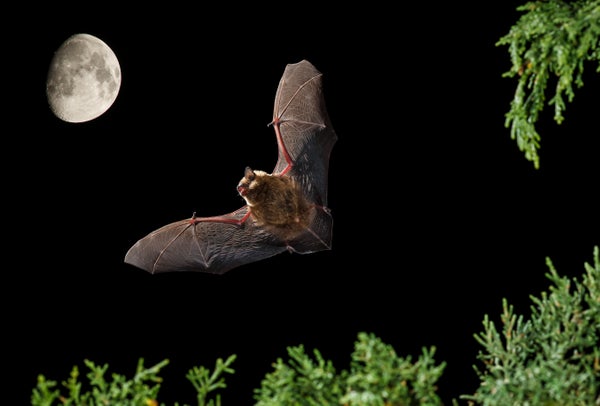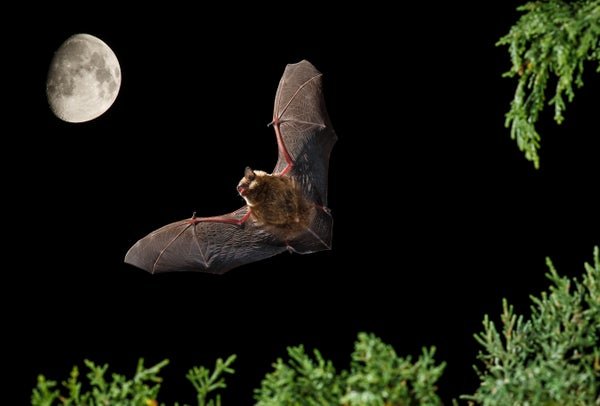November 21, 2023
3 min read
Dozens of mating bats caught on video at a Dutch church reveal an unusual use for their “huge” penises

Serotine bat (Eptesicus serotinus) flying at night in Spain.
Most mammals mate with penetrative sex, but one peculiar bat species with an oversize, bulbous penis seems to sweep that assumption aside. New video evidence suggests that during copulation, the male serotine bat—Eptesicus serotinus—instead uses its penis like an arm to push away the female’s tail membrane and presses the tip against the vulva, according to research published in Current Biology.
While collecting sperm samples from bats several years ago, University of Lausanne evolutionary biologist Nicolas Fasel observed dozens of bat erections and noticed that the species’ penis was “huge” and had an oddly shaped head. Once erect, the male serotine bat’s penis is almost a quarter of the length of the animal’s entire body—making it about seven times longer and wider than the female’s vagina.
“The shape is super strange; the top of the penis is a bit like this,” Fasel says, cupping his hands together to demonstrate the large, heart-shaped tip. He and his colleagues puzzled over how such a configuration would make penetration possible.
Fasel could think of two possible explanations: either the penis enlargement occurs after penetration, as it does in dogs, or the bats engage in contact mating, akin to the so-called cloacal kiss in birds—an arrangement in which sperm transfers when the rear orifices, or cloacae, of male and female birds come into contact.
By chance, Jan Jeucken, an amateur bat enthusiast and co-author of the new paper, had been observing a group of serotine bats that gathered in the attic of a church in the Netherlands. He e-mailed Fasel some videos of the bats copulating after hearing about the researcher’s interest in bat reproduction. In the videos, it was clear there was no penetration.
Fasel and his colleagues observed 93 instances of the bats copulating, mostly in videos shot by Jeucken. The footage shows males’ grasping females and then using their penis as a kind of “copulatory arm” to sweep aside the females’ tail membrane, Fasel says. The researchers theorized that hairs on the tip of the penis helped to position it against the vulva before ejaculation. Half of the copulations finished in less than an hour (although one lasted more than 12 hours). After copulation, the fur on the females’ abdomen appeared wet, suggesting that semen was deposited.
Teri Orr, a physiological ecologist at New Mexico State University, who was not involved in the study, says she was fairly shocked when she first read the paper. “It was such an unusual type of behavior that we don’t really know occurs in mammals,” she says. The researchers had the advantage of studying a colony centered on the attic, letting them “really pick apart what’s going on with this species,” Orr says.
Bats such as E. serotinus—which is common across Europe and Asia—are already known to have “unique and quite peculiar” reproductive behaviors, compared with other mammals, Fasel says. Males and females of many bat species can store sperm for months, and females can delay ovulation until after they hibernate, according to Orr.
The team did not swab the bats to confirm sperm transfer, but Fasel says he is confident that it occurred. “We could see that around the vulva, it was quite wet,” he says. Orr says subsequent research should pinpoint whether the sperm is being deposited and notes that there might also be the possibility of delayed sperm implantation, in which a fertilized egg remains inactive in the uterus for a length of time before it implants in the uterine wall and begins to develop— a phenomenon observed in female roe deer.
While the new finding comes from a small sample of one bat species, “I have no doubt that this is more widespread,” Fasel says. The behavior likely occurs among other bats whose females have a similar tail membrane, Orr says. Beyond the “gee-whiz” factor, these findings reveal important gaps in researchers’ knowledge about bat reproduction, she adds. “Bats are such a poorly understood group, and they tend to be vilified,” Orr says. “At the end of the day, if we don’t understand their reproductive biology, we’re going to be really challenged when it comes to conservation.”



